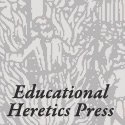Paul challenges the schooling system to look at alternative education for the answers to personalised learning and assessment. In doing so he looks at best practice in music education to illustrate his argument.
Rejoin The Revolution!
Ideas such as progressive teaching, child-centred learning, self-directed learning, discovery learning and personalised learning tend to go in and out of favour as differing fashions and trends sweep through the world commonly referred to as education and more accurately described as schooling. The most recent peak in interest in personalised learning was probably around 2005 when it looked like a revolution in teaching and learning was set to begin. This was just before the theory of learning styles was debunked, the backlash of which caused a lot of individualised learning strategies to be viewed with equal doubt and suspicion, which consequently killed enthusiasm for any kind of revolution in personalised learning. The evidence that debunked the theory of learning styles was overwhelming and the lesson that was well and truly learned, and that has been emphatically rammed home ever since, is that teaching strategies must be informed by a strictly scientific evidence based approach informed by big data and cognitive psychology rather than neuroscience, which one high profile and very respected educationist has referred to quite publicly and unashamedly as “neurobollocks.”
While there were clear lessons to be learned from the debunking of the theory of learning styles, there are fascinating and potentially much more enlightening things to be learned from the backlash against the theory of learning styles which could lead to profoundly positive changes in the entire world of education, not just in schooling. These lessons are nuanced and subtle but they are of immense importance to anyone who genuinely cares about the future of education. The fascinating and very telling phenomenon that has occurred due to the debunking of the theory of learning styles is that a host of eminent academics have labelled learning styles as a “neuromyth.” Notice that they say learning styles are a myth and not the theory of learning styles. As far as schooling is concerned there is no difference between learning styles and the theory of learning styles because the theory of learning styles postulates that if learners are taught via their preferred learning style they will learn better, but when they are summatively assessed this theoretical hypothesis has been proven to be false, therefore as far as schooling is concerned learning styles might as well not exist because when teaching strategies are adjusted to accommodate them there is no improvement in standardised test results. The theory of learning styles is undoubtedly wrong but while it might be fine to say that learning styles don’t or need not exist in schooling, it is an entirely wrong to say this if you are interested in education in a general sense.
The reason that the theory of learning styles is wrong is that anything learned via a particular learning style is best expressed via that same style, and, since summative assessments in school generally take the form of a written test which requires candidates to express the extent of their learning linguistically using words, symbols or pictures that can be written or drawn on a piece of paper, there is no allowance for meaning to be conveyed or expressed any other way. Apart from the movement of their pen candidates are generally not allowed to move or make a sound during a written exam and so any form of auditory or kinaesthetic expression would not be allowed and certainly would not form any part of anything that was formally assessed. The vast majority of prescribed curricular learning outcomes that are assessed in schooling are best expressed in written form because it is only learning in the cognitive domain expressed in written form that schooling assesses. Psychomotor and affective learning are generally of negligible interest. Contrary to the recent claims of legions of established and highly respected academics, learning styles are not a myth, they are very real and well documented, but instead of declaring that the theory of learning styles is nothing more than a myth (which is true) academics have been lining up to declare that learning styles are a myth (which is not true). The terms “learning styles” and “the theory of learning styles” have been used interchangeably in the media and are taken to mean the same thing in schooling because within a schooling environment they effectively are the same thing, but in the wider world of education they are subtly but crucially different. The misleading backlash against the theory of learning styles is just a minor symptom of a much bigger disease that afflicts schooling and, interestingly, it serves as a very useful way to exemplify and begin to explain the much bigger affliction and, even more interestingly, its potential cure.
One of the most serious diseases that blight schooling is that forms of learning that are not easily assessable using written exams or that do not make any difference in the outcomes of the conventional standard model of schooling are dismissed as a myth or of negligible importance. One of these forms of learning has proven itself to be the most important form of learning in human history. Without it the human species would not be significantly different from any other animal. Every significant original contribution or innovation from the wheel to the computer, in every field of human endeavour, has come about as a result of self directed learning; otherwise it would not have been original. Yet languishing at the bottom of one of John Hattie’s revered league tables of classroom interventions, as calculated using metadata from thousands of assessments that utilise standard assessment techniques, is “student control over learning” or self-directed learning. Standard assessments measure how well people learn prescribed learning intentions therefore if candidates prescribe their own learning intentions, as they do in self- directed or self-determined learning, their learning cannot be measured by conventional means and therefore it does not show up in any assessment data that is collected from schools. This leads academics to believe that these vital forms of learning are of negligible importance or don’t even exist, when they are in fact the very types of learning that help to set the human species apart from all other species and that also set us apart from computers and robots, which are increasingly taking jobs from humans as traditional industries become automated. The findings and conclusions from evidence based league tables of successful classroom interventions arrived at through the strict application of scientific method are yet another example that demonstrate how vitally important forms of learning end up being dismissed in school classrooms because they do not fit the prescribed curriculum/standard test model. If you strictly apply scientific method to a highly selective set of data taken from a highly contrived environment you can make science say anything you want it to depending on how the data is manipulated, filtered and selected. Of course scientific method is the only rational way forward, but the data that informs the science of schooling must be inclusive of all types of learning, and that means it needs to be derived from a much wider concept of assessment which takes a much wider concept of human ability into account. There is a vast amount of essential human ability that cannot be fully expressed via the very narrow window of a written exam. For those who are genuinely interested in systems of education which optimise the types of learning that are essential for our species to prosper in the future, it is not the vitally important forms of learning that should be dismissed: it is the conventional model of schooling.
The reason so many progressive or child-centred approaches to learning have never really taken off in the past in schools is because when teaching methodologies were changed to accommodate the principles of personalised learning, the approach to summative assessment remained the same. If the type of assessment utilised requires all candidates to express the extent of their knowledge of the same curricular learning intentions in the same way then success in such assessments is very rarely achieved through individual personalised learning techniques. The concept of personalised assessment may provoke a strongly negative kneejerk reaction from many educators for understandable reasons but there are good examples of personalised assessment that have been used for decades that prove that it can be done efficiently, effectively and fairly.
The best places to look for such examples are in areas of learning that necessitate forms of assessment which do not involve written exams. A perfect example is the music instrumental solo performance exam. The complexion of instrumental music instruction varies significantly in different areas in different countries; the assessment I will describe here is the Scottish Qualifications Authority solo performance assessment at levels 5, 6 and 7, with which I am the most familiar.
The great thing about learning a musical instrument is that it requires learners to learn in all three of the domains of learning. They need to learn cognitive concepts but also have to interpret the mood, style and feeling in the piece which requires them to learn in the affective domain. Music is sound and sound is created through movement, and so playing an instrument well requires a high degree of highly refined psychomotor learning. Consequently, rather than assessing through the narrow window of a written exam, which only assesses the extent to which candidates have learned prescribed cognitive concepts, a music performance exam requires candidates to express the extent of their cognitive, affective and psychomotor learning through the auditory medium of music. For example if candidates who play a stringed instrument were being asked to express the extent to which they understand the term vibrato in a written exam they may regurgitate the textbook definition, but in a solo performance music exam they would express the extent to which they understand the term by recognising the symbol in the music and adjusting the movement of their fingers to create the auditory musical effect, thus demonstrating their cognitive understanding of the term kinaesthetically via their psychomotor skills using the auditory medium of music.
The degree of personalisation and choice in such exams is practically limitless and the breadth of teaching methodologies open to music instructors covers the whole of the pedagogy, andragogy and heutagogy continuum. The reason there is so much choice for learners is due to the fact that there is no prescribed repertoire, instead the exam board give examples and guidelines at each level of assessment which means that if there is not a single piece of music in the known universe that a learner likes he or she can create his or her own and play that in the exam, as long as it meets or exceeds the minimum criteria for the level of assessment, thus learners’ imagination is their only limit when it comes to personalisation and choice.
There are a great many other aspects of instrumental instruction that differ from classroom teaching. Prospective instrumental music students are invited to be auditioned for places on an instructor’s timetable therefore their participation in learning is voluntary and consequently an instructor’s teaching is invited. This makes a huge difference to any of the vast array of teaching methodologies that are related to motivation. In instrumental instruction, motivation is much more intrinsic than extrinsic because students choose to participate voluntarily, whereas core subjects taught in classrooms are compulsory and the teaching of such subjects can often be uninvited. Students are taught them whether they like it or not. Teaching and learning depends heavily on motivation and instrumental instruction and classroom teaching involve entirely opposite forms of motivation.
The absence of a prescribed repertoire for instrumental music learners allows for four learning pathways which can be mixed and matched according to learner preference. If learners prefer the default pieces chosen by their instructor this allows for a traditional teacher led pedagogical pathway, if they prefer to learn a mixture of self and instructor chosen pieces this leads to an andragogical learning pathway, if they decide to source their own learning content this leads to an andragogical/heutagogical open source learning self directed pathway and if learners enjoy creating music then learning intentions can be entirely learner created, in which case the content of the assessment is created by the learner. Learners have been successfully assessed with excellent results at all levels of school assessment on pieces that they have created. This last approach is entirely self-determined and heutagogical. These alternative learning pathways offer a significant shift of emphasis that makes music instruction profoundly different from classroom teaching. Another important consideration is that classroom teachers’ subject knowledge tends to lie within either the primary, secondary, or tertiary levels of assessment but instructors have to have knowledge of all three; this is yet another crucial and fundamental difference. It means that learners can learn at their own pace which can be as much as four years ahead or behind the level of average exam board age-stage expectations commonly found in classrooms. This means for example that there is no learning ceiling in the last year of secondary school because keen music students taught by instructors can study undergraduate university level material if they want to.
The above example illustrates how music instructors use personalised learning in conjunction with personalised assessment which can only be possible because the exam board does not prescribe learning intentions; instead it prescribes criteria which the learning intentions have to comply with at each level of assessment. It is interesting that music instructors implement the principles of what is sometimes called “alternative learning” (voluntary, non-coercive, convivial learning) within the institutions of mainstream formal learning; it shows that it can be done. Their approach to teaching, learning and assessment has been used very successfully in music exams for decades and if it could be translated, developed and widened to other disciplines there is no reason why personalised learning and assessment cannot work in ways that are far more suitable and efficient than the ubiquitous traditional methods that have been associated with classroom teaching for the last 150 years.
It is intriguing to think that personalised learning in conjunction with personalised assessment could form part of a very effective treatment which may even lead to a possible and much sought after cure for the very poorly patient known as schooling. In the world of medicine such treatments would be tested in clinical trials before they could be licensed for use on the general public, but in education such trials have already been carried out in the world sometimes referred to “alternative education” and the results have been very positive. So much so that Sir Ken Robinson, one of the world’s most highly respected educationists, has recently declared that “alternative education works” and that we should be making every possible effort to bring the methodologies of alternative learning to the mainstream. There are millions of people from all around the globe who have benefited greatly from alternative approaches to learning such as unschooling, flexischooling and democratic free schooling and there is more and more research coming out to confirm what they already know and what educationists are beginning to discover: it works. Will policy makers listen? History has shown that they will not and therefore the only way change is likely to happen is through a ground up revolution. If you have read this article thus far then you are either part of the revolution or you have the potential to be part of it. To be part of it all you need to do is spread the word.
Paul Henderson, May, 2017.











